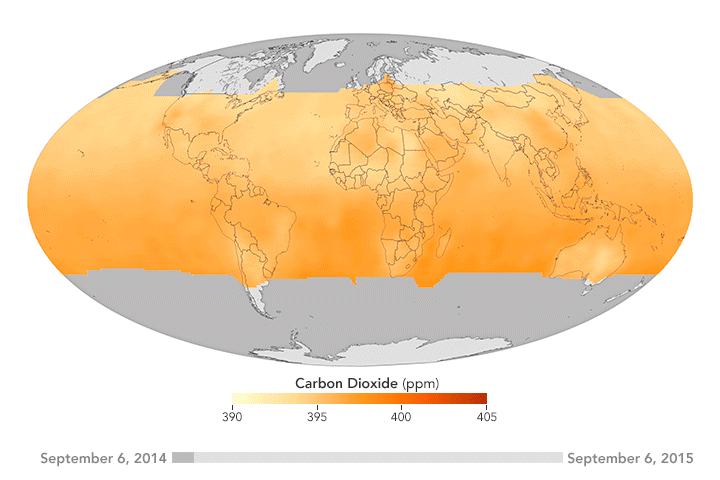Since the beginning of the industrial age, the mean concentration of atmospheric carbon dioxide has increased from 280 parts per million to 400 parts per million.
"We're running the most dangerous experiment in history right now, which is to see how much carbon dioxide the atmosphere... can handle before there is an environmental catastrophe."Over the past year, NASA's Orbiting Carbon Observatory-2 has been collecting global measurements of atmospheric carbon dioxide:
― Elon Musk
 |
| Atmospheric carbon dioxide concentration NASA's Orbiting Carbon Observatory-2 |
Carbon dioxide concentrations were much higher a half a billion years ago because Earth was a rocky planet bereft of carbon sequestrating plant life. During the Devonian period 420 to 360 million years ago, Earth's atmosphere underwent a 15-fold decline in carbon dioxide.
"The decline is thought to be primarily attributable to carbon sequestration caused by the evolutionary emergence of large forest trees." ― The Forest PrimevalAtmospheric carbon dioxide concentrations have been rising steadily since the industrial age:
 |
| Actual and projected atmospheric carbon dioxide concentrations source: Hannes Grobe |
Much, if not most of life on Earth has an existential and symbiotic relationship with Earth's atmosphere. Animals must inhale and exhale to maintain life. Trees must sequester atmospheric carbon to grow a woody skeleton.
The word respire comes from the old French respirer or the Latin respirare meaning:
‘breathe out,’ from re- ‘again’ + spirare ‘breathe.’Earth is planet of respiration. Earth is a breathing planet like no other planet we know.
What we call ’I’ is just a swinging door, which moves when we inhale and when we exhale.
― Shunryū Suzuki
REFERENCES
- A Breathing Planet, Off Balance, NASA, 12 November 2015.
- Excitement Grows as NASA Carbon Sleuth Begins Year Two, NASA/JPL-Caltech, 29 October 2015.
- The Forest Primeval, GrokEarth, 21 November 2015.


